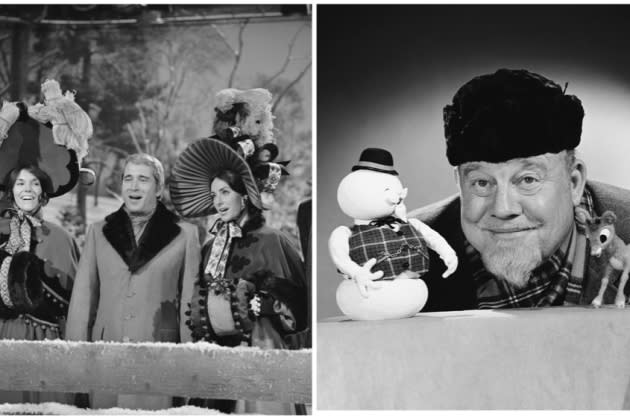Perry Como’s and Burl Ives’ Christmas Songs Top ASCAP Annual Holiday Chart

In his recent book “The Philosophy of Modern Song,” Bob Dylan described Perry Como as a “downright incredible” performer who “lived in every moment of every song he sang… When he stood and sang, he owned the song and he shared it and we believed every single word. What more could you want from an artist?”
So maybe that’s a contributing factor to why a song that Como popularized, “It’s Beginning to Look a Lot Like Christmas,” tops ASCAP’s annual list of the most-played Christmas songs in the U.S. Because when when as authoritative a figure as Como says Christmas is coming, you damn well believe it is.
More from Variety
Coming up behind “Beginning” at No. 2 is “Sleigh Ride,” the tune that would have seemed to enjoy (North) pole position, since it was last year’s ASCAP chart leader. Sitting pretty at No. 3 is “A Holly Jolly Christmas,” first sung by Burl Ives for the perennial “Rudolph the Red-Nosed Reindeer” TV special. The “Rudolph” song itself is at No. 5, preceded by the reiterative “Let It Snow, Let It Snow, Let It Snow” at No. 4.
So where, fandoms may ask, is “All I Want for Christmas Is You”? The answer is: at No. 9. (See full chart below.) This may seem counterintuitive, since Mariah Carey’s enduring smash from the 1990s has become more popular than ever in recent years, reaching No. 1 on the Billboard Hot 100 during the last four Decembers in a row, including (as of a few days ago) this one.
While the performing rights org does not provide explanations for why some songs might do better than others in the collected streaming and radio data, there are a couple of clear reasons why even older chestnuts than “All I Want” might be favored in these annual rankings. For one thing, it tracks all the different renditions of a song that are getting played. And “It’s Beginning to Look a Lot Like Christmas” is like many of the others on the chart in being oft-covered; though Como had arguably the most popular recording of it, versions of it by Bing Crosby and Johnny Mathis also get loads of airplay as well. And Michael Bublé had it on his 2011 Christmas album, which continues to be monstrously big. On the other hand, how many star performers have wanted to cover Mariah’s self-co-penned tune and be compared to her? That number is fall smaller.
Also perhaps factoring in is that the data is collected early in the holiday season, where a song about how it’s “beginning” to look like Christmas is thematically most appropriate, whereas radio programmers who’ve flipped to all-Xmas at Thanksgiving may be trying not to burn listeners out on Mariah’s ubiquitous seasonal staple too early. And the pre-’70s classics are undoubtedly getting massive play on easy-listening stations and streaming platforms that do not report to any Billboard charts but are captured by ASCAP for collections.
(As an asterisk, the ASCAP chart represents streaming and terrestrial radio data, and only songs written or co-written by the PRO’s signatories are included, so anything with solely BMI writers will not appear.)
As expected, modern songs don’t fare too well. Aside from Carey’s contribution to the canon, there are only two more songs out of 25 that have origins any newer than 1970: Paul McCartney’s 1979 “Wonderful Christmastime” and Kelly Clarkson’s 2013 “Underneath the Tree.” Wham!’s “Last Christmas” is usually on there representing the modern division too, but after appearing on the chart at No. 11 last year, it’s dropped out for 2022.
If you’re looking for a writer to crown King of Christmas, look no further than Johnny Marks, the only one with more than one composition on the list. He has three — “Holly Jolly,” “Rudolph” and “Rockin’ Around the Christmas Tree.”
THE TOP 25 MOST PLAYED ASCAP HOLIDAY SONGS OF 2022:
“It’s Beginning to Look a Lot Like Christmas” by Meredith Willson** (1951)
“Sleigh Ride” by Leroy Anderson** and Mitchell Parish** (1948)
“A Holly Jolly Christmas” by Johnny Marks** (1962)
“Let It Snow, Let It Snow, Let It Snow” by Sammy Cahn** and Jule Styne** (1945)
“Rudolph the Red-Nosed Reindeer” by Johnny Marks** (1949)
“Jingle Bell Rock” by Joseph Carleton Beal and James Ross Boothe (1958)
“It’s the Most Wonderful Time of the Year” by Edward Pola and George Wyle (1963)
“Santa Claus Is Comin’ to Town” by Fred Coots** and Haven Gillespie** (1934)
“All I Want for Christmas Is You” by Walter Afanasieff and Mariah Carey** (1994)
“Rockin’ Around the Christmas Tree” by Johnny Marks** (1958)
“White Christmas” by Irving Berlin** (1941)
“The Christmas Song” by Mel Tormé and Robert Wells (1946)
“Feliz Navidad” by José Feliciano (1970)
“Winter Wonderland” by Felix Bernard and Richard B. Smith (1934)
“Have Yourself a Merry Little Christmas” by Ralph Blane** and Hugh Martin** (1944)
“Frosty the Snowman” by Steve Nelson and Walter E. Rollins (1950)
“Here Comes Santa Claus (Down Santa Claus Lane)” by Gene Autry and Oakley Haldeman (1947)
“Jingle Bells” (Frank Sinatra version), arranged by Gordon Jenkins** (1958)
“You’re a Mean One, Mr. Grinch” by Dr. Seuss and Albert Hague (1966)
“Deck the Halls” (Nat King Cole version), arranged by Nat King Cole and Leland Gillette (1960)
“Santa Baby” by Joan Javits, Anthony Springer and Philip Springer (1953)
“Underneath the Tree” by Kelly Clarkson and Greg Kurstin (2013)
“Wonderful Christmastime” by Paul McCartney** (1979)
“Blue Christmas” by Billy Hayes and Jay Johnson (1949)
“Silver Bells” by Ray Evans** and Jay Livingston** (1950)
(The double-asterisks after writers’ names indicate those whom ASCAP has indicated are members of the Songwriters Hall of Fame.)
While a couple of the included songs, “Deck the Halls” and “Jingle Bells,” are in the public domain, the particular arrangements count as writing credits for the ASCAP-affiliated writers.
Best of Variety
Sign up for Variety’s Newsletter. For the latest news, follow us on Facebook, Twitter, and Instagram.

